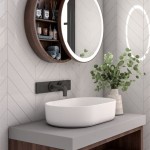How To Hang A Mirror On A Tile Wall Without Drilling
Hanging a mirror on a tile wall can be a challenge, especially if you want to avoid drilling holes. Tile is a hard and unforgiving surface, and traditional hanging methods like nails or screws may not be feasible. However, there are several effective and damage-free solutions for securely hanging your mirror without drilling.
1. Adhesive Hooks and Strips
Adhesive hooks and strips offer a simple and convenient method for hanging lightweight mirrors. These products are readily available in various sizes and weight capacities, making them suitable for different mirror sizes. The adhesives used in these products are designed to adhere strongly to smooth surfaces like tile, providing reliable support.
When using adhesive hooks or strips, it is crucial to follow the manufacturer's instructions carefully. Ensure the surface is clean and dry before application. Allow the adhesive to cure completely before hanging the mirror, as this helps to maximize its holding power.
For added security, consider using multiple adhesive hooks or strips, especially for larger or heavier mirrors. Remember to distribute the weight evenly across the hooks or strips to prevent them from detaching.
2. Command Strips
Command strips are another popular option for hanging decorative items on tile walls without drilling. These strips come in various sizes and weight capacities, making them suitable for a wide range of mirrors. The unique adhesive used in Command strips allows for easy removal without leaving any damage or residue on the tile surface.
To use Command strips, simply follow these steps:
- Clean the tile surface with rubbing alcohol to ensure proper adhesion. Allow the surface to dry completely.
- Apply the Command strips to the back of the mirror, ensuring they are positioned evenly and securely.
- Press the mirror firmly against the tile, ensuring all strips are making contact.
- Allow the strips to cure for the recommended time before applying any weight to the mirror.
Command strips offer a temporary solution, and their holding power may diminish over time, especially with heavier mirrors. Regular inspection and readjustment may be necessary to maintain their effectiveness.
3. Suction Cup Hooks
Suction cup hooks provide a temporary and damage-free option for hanging mirrors on tile walls. These hooks typically consist of a suction cup that adheres to the tile surface, creating a secure hold. They are readily available in various sizes and designs, offering a versatile solution for different mirror sizes.
To use suction cup hooks effectively, ensure the tile surface is clean and free of debris. Apply firm pressure to the suction cup to create a strong seal. It is advisable to test the suction cup's holding power before hanging the mirror, especially for heavier items.
While suction cup hooks can be a convenient option, their holding power may be compromised by high humidity or exposure to heat. They are not suitable for permanent installations or for hanging heavy items.
4. Mirror Clips
Mirror clips provide a secure and aesthetically pleasing way to hang a mirror on a tile surface without drilling. These clips typically attach to the mirror's frame and secure it to the tile using adhesive or screws that are concealed behind the mirror.
When using mirror clips, carefully measure the distance between the clips and the mirror's frame to ensure a secure fit. Use a level to ensure the mirror is hung straight. If using adhesive clips, follow the manufacturer's instructions for proper application and curing time.
Mirror clips offer a more permanent solution than adhesive hooks or strips, but they may require a small hole to be drilled in the tile for screw installation. However, these holes can be easily concealed behind the mirror.
5. Hanging Wire and Hooks
For heavier mirrors, a hanging wire and hooks system is a good option. This method involves attaching a hanging wire to the back of the mirror and then using hooks mounted on the tile wall to secure the wire. The hooks can be either adhesive or screw-mounted, depending on the weight of the mirror and the desired level of permanence.
When using this method, ensure the hanging wire is strong enough to support the weight of the mirror. The hooks should be spaced appropriately to ensure even weight distribution. If using adhesive hooks, follow the manufacturer's instructions for proper installation and curing time.
This method offers a more secure and sturdy solution for hanging heavier mirrors, but it may require some drilling for screw-mounted hooks. However, the holes can be easily concealed behind the mirror.

How To Hang A Mirror On Tile Wall Remington Avenue

How To Hang Mirrors On Tile 3 Ways A Bonus The Palette Muse

How To Hang A Mirror On Tile Wall Remington Avenue

How To Hang Mirrors On Tile 3 Ways A Bonus The Palette Muse

How To Hang A Bathroom Mirror Over Tile Wainscoting Mimzy Company

How To Hang A Mirror On Wall Without Nails

How To Hang A Bathroom Mirror Over Tile Wainscoting Mimzy Company

How To Hang A Hanging Mirror Without Accompanying Hardware

How To Hang A Bathroom Mirror Over Tile Wainscoting Mimzy Company

Diy Mosaic Tile Bathroom Mirror Centsational Style








